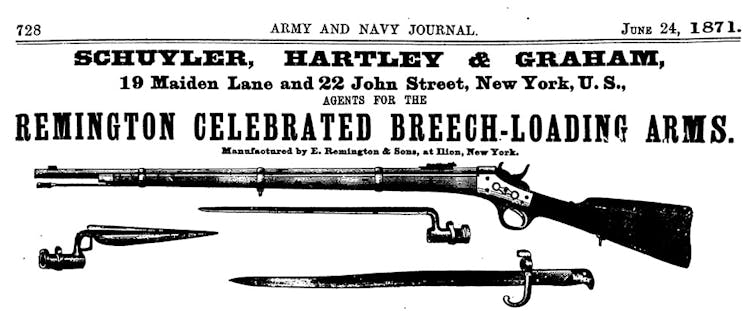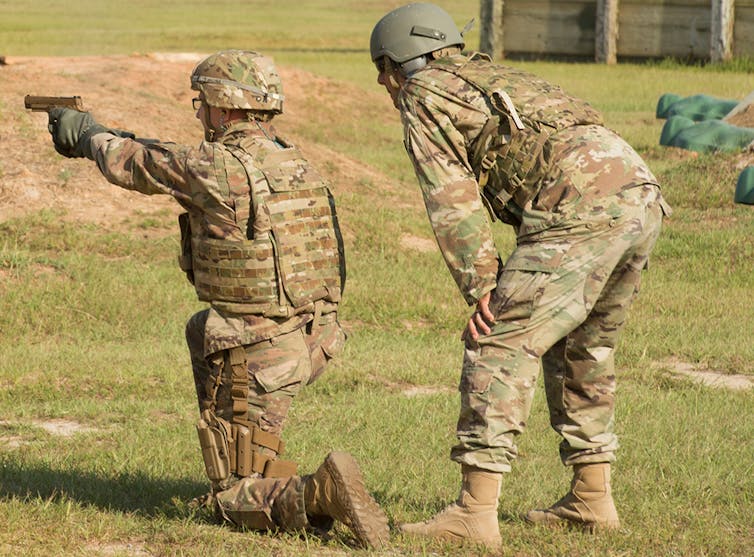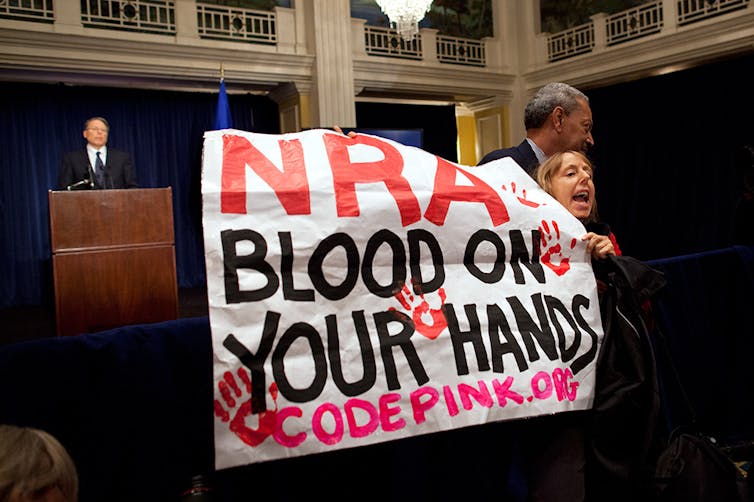Photo by Miami photojournalist Wilfredo Lee for AP accompanied this piece by Brian DeLay published by The Conversation published an updated version of an article, "How the US government created and coddled the gun industry," published by the Conversation on 10/9/2017. The photographs in the body are also from the piece.
The Conversation is a collaboration between editors and academics to provide news analysis and commentary that is free to read and republish using a Creative Commons, no derivatives licence. DeLay, Associate Professor in History at the University of California, Berkeley (bio and contact information) is the author of War of a Thousand Deserts: Indian Raids and the U.S.-Mexican War (Yale, 2008), and is now at work on a book for W. W. Norton about guns, freedom, and domination in the Americas, called Shoot the State. Brian DeLay receives funding from the American Council of Learned Societies and the Harry Frank Guggenheim Foundation. University of California provides funding as a founding partner of The Conversation.
*
On his facebook page, DeLay advocates even more specifically for how we might take on the NRA:
People who are sick and shamed by the way things are should take inspiration from the NRA and try to mobilize public consumers. Government contracts account for something like 40% of gun-maker revenue in this country. While citizen activism isn’t likely to influence military contracting anytime soon, states, counties, and municipalities buy lots of guns, too.
Again, take Smith & Wesson, maker of the AR-15 used to kill 14 kids and 3 teachers on Wednesday. S&W won the main handgun contract for the LAPD a few years ago. Most of Los Angeles’s leaders and their constituents support common-sense gun legislation, legislation that Smith & Wesson pays to prevent. And yet it doesn’t seem that Smith & Wesson’s political interventions hurt their ability to win the LAPD contract. In effect, gunmakers have learned to be highly sensitive to the NRA, but have not yet been made to worry that doing so will imperil the government contracting side of their business.
Why not make them worry? Ask your local, county, and state representatives where they get their guns. Gunmakers don't all kiss the NRA ring in the same way, but they're all locked in intense competition with one another. Big contracts matter. Even smaller public contracts matter, if for no other reason than the prestige of being able to say "X number of police departments across the country use our handguns." If enough concerned citizens make enough noise, our representatives might consider taking a firm's political activities into account when awarding contracts.
If a firm like Smith & Wesson lost even one major contract because its political activities imperiled public safety, that could be a powerful precedent and a check on their seemingly unrestrained embrace of the NRA and NSSF. It could be a start.
*
As teenagers in Parkland, Florida, dressed for the funerals of their friends – the latest victims of a mass shooting in the U.S. – weary outrage poured forth on social media and in op-eds across the country. Once again, survivors, victims’ families and critics of U.S. gun laws demanded action to address the never-ending cycle of mass shootings and routine violence ravaging American neighborhoods.
The 14 children and three adults shot dead on Feb. 14 at Marjory Stoneman Douglas High School were casualties of the nation’s 30th mass shooting this year – defined by the Gun Violence Archive as involving at least four victims including the injured – and one of the deadliest in U.S. history. A question on many minds is whether this massacre will finally compel Washington to act. Few commentators seem to believe so.
If advocates for reform despair, I can understand. The politics seem intractable. It’s easy to feel powerless.
But what I’ve learned from a decade of studying the history of the arms trade has convinced me that the American public has more power over the gun business than most people realize. Taxpayers have always been the arms industry’s indispensable patrons.

Washington’s patronage
The U.S. arms industry’s close alliance with the government is as old as the country itself, beginning with the American Revolution.
Forced to rely on foreign weapons during the war, President George Washington wanted to ensure that the new republic had its own arms industry. Inspired by European practice, he and his successors built public arsenals for the production of firearms in Springfield and Harper’s Ferry. They also began doling out lucrative arms contracts to private manufacturers such as Simeon North, the first official U.S. pistol maker, and Eli Whitney, inventor of the cotton gin.
The government provided crucial startup funds, steady contracts, tariffs against foreign manufactures, robust patent laws, and patterns, tools and know-how from federal arsenals.
The War of 1812, perpetual conflicts with Native Americans and the U.S.-Mexican War all fed the industry’s growth. By the early 1850s, the United States was emerging as a world-class arms producer. Now-iconic American companies like those started by Eliphalet Remington and Samuel Colt began to acquire international reputations. Even the mighty gun-making center of Great Britain started emulating the American system of interchangeable parts and mechanized production.

Profit in war and peace
The Civil War supercharged America’s burgeoning gun industry.
The Union poured huge sums of money into arms procurement, which manufacturers then invested in new capacity and infrastructure. By 1865, for example, Remington had made nearly US$3 million producing firearms for the Union. The Confederacy, with its weak industrial base, had to import the vast majority of its weapons.
The war’s end meant a collapse in demand and bankruptcy for several gun makers. Those that prospered afterward, such as Colt, Remington and Winchester, did so by securing contracts from foreign governments and hitching their domestic marketing to the brutal romance of the American West.
While peace deprived gun makers of government money for a time, it delivered a windfall to well-capitalized dealers. That’s because within five years of Robert E. Lee’s surrender at Appomattox, the War Department had decommissioned most of its guns and auctioned off some 1,340,000 to private arms dealers, such as Schuyler, Hartley and Graham. The Western Hemisphere’s largest private arms dealer at the time, the company scooped up warehouses full of cut-rate army muskets and rifles and made fortunes reselling them at home and abroad.

More wars, more guns
By the late 19th century, America’s increasingly aggressive role in the world insured steady business for the country’s gun makers.
The Spanish American War brought a new wave of contracts, as did both World Wars, Korea, Vietnam, Afghanistan, Iraq and the dozens of smaller conflicts that the U.S. waged around the globe in the 20th and early 21st century. As the U.S. built up the world’s most powerful military and established bases across the globe, the size of the contracts soared.
Consider Sig Sauer, the New Hampshire arms producer that made the MCX rifle used in the Orlando Pulse nightclub massacre. In addition to arming nearly a third of the country’s law enforcement, it recently won the coveted contract for the Army’s new standard pistol, ultimately worth $350 million to $580 million.
Colt might best illustrate the importance of public money for prominent civilian arms manufacturers. Maker of scores of iconic guns for the civilian market, including the AR-15 carbine used in the 1996 massacre that prompted Australia to enact its famously sweeping gun restrictions, Colt has also relied heavily on government contracts since the 19th century. The Vietnam War initiated a long era of making M16s for the military, and the company continued to land contracts as American war-making shifted from Southeast Asia to the Middle East. But Colt’s reliance on government was so great that it filed for bankruptcy in 2015, in part because it had lost the military contract for the M4 rifle two years earlier.
Overall, gun makers relied on government contracts for about 40 percent of their revenues in 2012.
Competition for contracts spurred manufacturers to make lethal innovations, such as handguns with magazines that hold 12 or 15 rounds rather than seven. Absent regulation, these innovations show up in gun enthusiast periodicals, sporting goods stores and emergency rooms.

NRA helped industry avoid regulation
So how has the industry managed to avoid more significant regulation, especially given the public anger and calls for legislation that follow horrific massacres like the one in Las Vegas?
Given their historic dependence on U.S. taxpayers, one might think that small arms makers would have been compelled to make meaningful concessions in such moments. But that seldom happens, thanks in large part to the National Rifle Association, a complicated yet invaluable industry partner.
Prior to the 1930s, meaningful firearms regulations came from state and local governments. There was little significant federal regulation until 1934, when Congress – spurred by the bloody “Tommy gun era” – debated the National Firearms Act.
The NRA, founded in 1871 as an organization focused on hunting and marksmanship, rallied its members to defeat the most important component of that bill: a tax meant to make it far more difficult to purchase handguns. Again in 1968, the NRA ensured Lyndon Johnson’s Gun Control Act wouldn’t include licensing and registration requirements.
In 1989, it helped delay and water down the Brady Act, which mandated background checks for arms purchased from federally licensed dealers. In 1996 the NRA engineered a virtual ban on federal funding for research into gun violence. In 2000, the group led a successful boycott of a gun maker that cooperated with the Clinton administration on gun safety measures. And it scored another big victory in 2005, by limiting the industry’s liability to gun-related lawsuits.
Most recently, the gun lobby has succeeded by promoting an ingenious illusion. It has framed government as the enemy of the gun business rather than its indispensable historic patron, convincing millions of American consumers that the state may at any moment stop them from buying guns or even try to confiscate them.
This helps explain why the share price of gun makers so often jumps after mass shootings. Investors know they have little to fear from new regulation and expect sales to rise anyway.
A question worth asking
So with the help of the NRA’s magic, major arms manufacturers have for decades thwarted regulations that majorities of Americans support.
Yet almost never does this political activity seem to jeopardize access to lucrative government contracts.
Americans interested in reform might reflect on that fact. They might start asking their representatives where they get their guns. It isn’t just the military and scores of federal agencies. States, counties and local governments buy plenty of guns, too.
Take Smith & Wesson, maker of the AR-15 Nikolas Cruz just used to kill his teachers and classmates at the Marjory Stoneman Douglas High School. Smith & Wesson is well into a five-year contract to supply handguns to the Los Angeles Police Department, the second-largest in the country. In 2016 the company contributed $500,000 (more than any other firm) to a get-out-the-vote operation designed to defeat candidates who favor tougher gun laws.
Do voters in LA – or in the rest of the country – know that they are indirectly subsidizing the gun lobby’s campaign against regulation? Concerned citizens should begin acting like the consumers they are and holding gun makers to account for political activities that imperil public safety.
